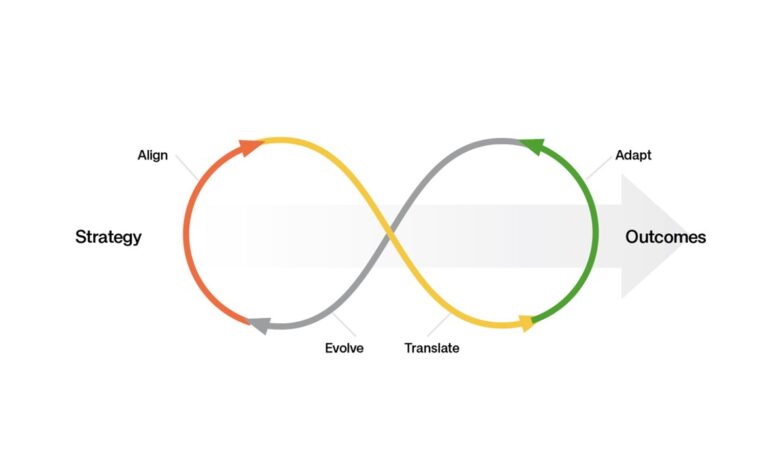
When a business struggles to meet its planned goals, alarm bells inevitably sound.
Leadership teams scramble to diagnose issues and recalibrate for the next quarter. In the rush, strategic planning often takes a backseat to immediate crisis management.
Over time, even as the crisis fades, priorities drift, communication falters, and evolving market conditions widen the gap between strategic objectives and everyday execution.
Too often, the alarm bells ring again, and the cycle repeats.
This “strategy-market gap” — the growing disconnect between corporate ambitions and operational reality — holds the business back from achieving their goals.
This can become fatal when left unchecked. Kodak, the inventor of the first megapixel camera, serves as a stark example. Despite its groundbreaking innovations, the company failed to adapt to market disruption, ultimately becoming a cautionary tale in strategic mismanagement, because they were too busy focusing on the wrong aspects of their business to seize the opportunity that was at their fingertips.
Kodak is not alone: Blockbuster, Nokia, and many others have suffered similar fates. In fact, 90% of organizations fail to successfully execute strategies.
There appears to be a systemic issue at the heart of business, one which keeps an overwhelming number of companies limited to a faltering pursuit of their goals. But now, AI is emerging as a game-changing force, helping businesses bridge the gap and stay on track.
Using AI to bridge the strategy-market gap
Businesses that differentiate themselves in delivering products and services are increasingly leveraging AI, institutional knowledge and proprietary data. The same approach can be applied to strategy execution.
Increasingly, smart businesses are looking to AI-driven tools and platforms to integrate continuous data analysis, real-time scenario planning, and agile resource allocation to support decision-making. In doing so, they can cultivate much needed situational awareness, comprehensively considering potential risks and changing conditions.
Consider an AI-first unified platform that combines advanced market intelligence with traditional project management tools. Such a system can dynamically prioritize tasks based on external factors, ensuring teams remain aligned with strategic goals and help cultivate an awareness of the factors impacting their industry.
The result here is a more resilient organization, better equipped to navigate an unpredictable landscape. In turn, this allows leadership to focus their attention on fostering long-term growth and enacting lasting change within their field.
Digital Twins: A New Frontier in Business Strategy
One of the most exciting developments is the application of Digital Twins to corporate strategy. Traditionally used in engineering, a digital twin is a continuously evolving digital replica of a system.
Applied to business, this technology enables leaders to simulate and refine strategic initiatives in a risk-free environment before executing them in reality.
By replicating the decision-making DNA of an organization, business leaders are better able to acknowledge and consider possibilities that may have otherwise gone unnoticed or been ill-considered, becoming better informed in the process. When these imagined outcomes are blended with real time insights and data on market trends, their utility to executives becomes ever more apparent.
By modeling various scenarios and incorporating real-time market data, executives gain deeper insights into potential outcomes and awareness of the impact of internal and external operating conditions. This approach enhances strategic decision-making, blending human expertise with AI-driven foresight. AI-generated insights can anticipate challenges and opportunities, helping leaders proactively choose the best course of action.
With digital twins, organizations can optimize their strategies, prepare for unexpected market shifts, and maximize resilience.
AI for Cross-Organizational Alignment
As demonstrated, AI has unparalleled potential to refine strategy execution and enable informed decision-making. However, when technology-driven change happens in isolation, it risks leaving employees behind.
For an AI-driven approach to strategy execution to succeed, alignment across the organization is crucial.
AI agents can address this by acting as real-time communication hubs, ensuring that updated objectives and strategic changes are disseminated seamlessly. Through intelligent nudges and automated reminders, AI can keep teams on schedule, translating high-level strategies into actionable tasks.
This continuous, data-driven feedback loop enables businesses to remain agile while keeping employees engaged, informed and hyper-aligned on what comes next.
When done well, it ultimately means that everyone understands and is able to work towards executing the company’s strategy.
The Future of Strategy Execution
All of this would not have been possible just a few years ago.
But the traditional, static models of strategic planning and execution are no longer fit for purpose in today’s fast-moving business landscape. Where once we had Kodak, Nokia and Blockbuster, we may soon see many hundreds more businesses meet the same fate.
AI offers an unprecedented opportunity to align strategy with execution dynamically, allowing organizations to adapt to real-world shifts in real time.
It will allow leaders to break free from cycles of reactive crisis management and build organizations that are not only resilient but also forward-looking. AI is not just a tool of the future—it is a necessity for businesses that want to anticipate that future, stay competitive, and successfully execute their strategies in an ever-evolving world.
It will be the difference between the 90% of organizations that struggle to implement and the 10% who succeed and thrive.




